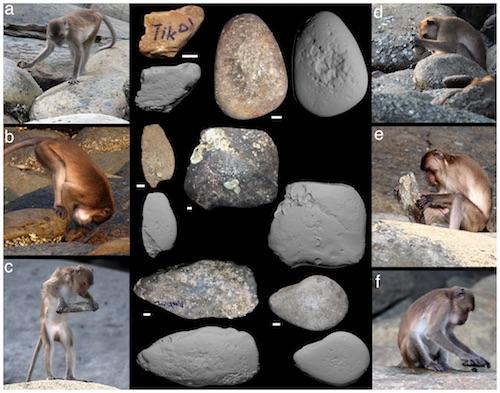Wesley J. Smith
Source - http://www.evolutionnews.org/2016/06/monkeys_do_not102914.html
 Haslam M, Gumert MD, Biro D, Carvalho S, Malaivijitnond S (2013) [CC BY 2.5], via Wikimedia Commons
Haslam M, Gumert MD, Biro D, Carvalho S, Malaivijitnond S (2013) [CC BY 2.5], via Wikimedia Commons
It is amazing how some in the sciences are so desperate to knock humans off the pedestal of exceptionalism. Ironically, a primary manner in which they seek to do this is by demonstrating how animals are like us -- indirectly admitting our special status.
Latest example? Monkeys supposedly have a "stone age culture" because some have used tools made of durable natural materials. From "Monkey 'Archeology' Reveals Macaque's Own Stone Age Culture," in New Scientist:
The world's first archaeology dig of an old world monkey culture has uncovered the tools used by previous generations of wild macaques -- a group of primates separated from humans by some 25 million years of evolution. The discovery means humans aren't unique in leaving a record of our past culture that can be pried open through archaeology.
Only a few decades ago scientists thought that humans were the only species to have worked out how to turn objects in their environment into useful tools. We now know all sorts of animals can do the same - but the tools of choice are usually perishable materials like leafs and twigs. This makes the origin of these behaviours difficult to study, especially when you consider that the record of hominin stone tool use stretches back more than 3 million years.
Burmese long-tailed macaques are a rare exception. They are renowned for their use of stone tools to crack open shellfish, crabs and nuts, making them one of the very few primates that have followed hominins into the Stone Age.
Please. Using stones does not make a culture.
Here are the "Seven Elements of Culture":
-
Customs: Are the written and unwritten rules of society. They can refer to a culture's laws, but also its moral and ethical expectations.
-
Religion: Unites people under a common belief system and values. Religion is the most important aspect of many people's lives, and is a major bonding factor within communities.
-
Government: Offers protection and order, and defines power and responsibility within a culture.
-
Language: Can act to join people of the same culture, but can also distinguish people of different sub-groups within a common culture.
-
Communication: Vital to the spread of culture, so you can see how having the same language is important in cultural terms.
-
Arts: Art and literature is one of the most powerful ways of spreading cultural knowledge and beliefs.
-
Economy: A culture's economy regulates what it needs to survive in terms of resources.
Using stones in the manner of tools? Nope.
And was anything really new learned in this dig? Not much.
We know from eyewitness accounts that these monkeys have been using tools for at least 120 years, so the study doesn't push the age of the behaviour back. But Haslam sees it as a first step towards digging deeper into the origins of the behaviour.
In other words, this is a big nothing burger.
The real human stone age culture included all seven elements, for example, explicit creativity (the incredible beauty seen in the cave paintings), the emergence of moral agency, the coming together of clans and tribes with governing rules, inventing, burying the dead (implying a spiritual belief), an aesthetic sense, evidenced by the making of jewelry, and on and on and on.
Monkeys using stones for tools? That's not culture, at least, not in the sense that humans create, mold, and shape it. Nice try fellas, but no cigar.